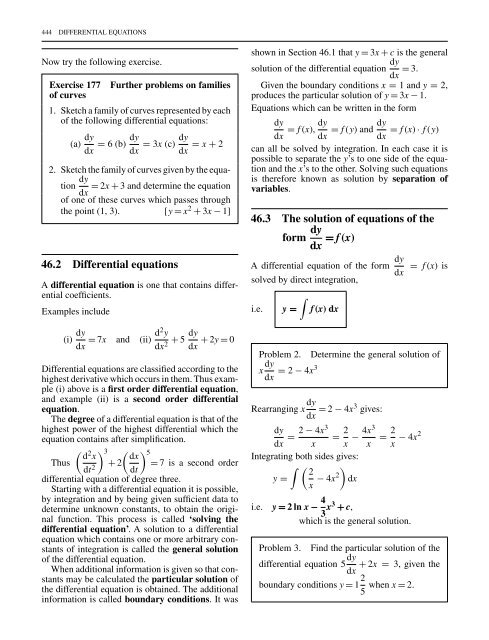differential equation
You also want an ePaper? Increase the reach of your titles
YUMPU automatically turns print PDFs into web optimized ePapers that Google loves.
444 DIFFERENTIAL EQUATIONS<br />
Now try the following exercise.<br />
Exercise 177 Further problems on families<br />
of curves<br />
1. Sketch a family of curves represented by each<br />
of the following <strong>differential</strong> <strong>equation</strong>s:<br />
(a) dy dy dy<br />
= 6 (b) = 3x (c)<br />
dx dx dx = x + 2<br />
2. Sketch the family of curves given by the <strong>equation</strong><br />
dy = 2x + 3 and determine the <strong>equation</strong><br />
dx<br />
of one of these curves which passes through<br />
the point (1, 3). [y = x 2 + 3x − 1]<br />
46.2 Differential <strong>equation</strong>s<br />
A <strong>differential</strong> <strong>equation</strong> is one that contains <strong>differential</strong><br />
coefficients.<br />
Examples include<br />
(i) dy<br />
dx = 7x and (ii) d2 y<br />
dx 2 + 5 dy<br />
dx + 2y = 0<br />
Differential <strong>equation</strong>s are classified according to the<br />
highest derivative which occurs in them. Thus example<br />
(i) above is a first order <strong>differential</strong> <strong>equation</strong>,<br />
and example (ii) is a second order <strong>differential</strong><br />
<strong>equation</strong>.<br />
The degree of a <strong>differential</strong> <strong>equation</strong> is that of the<br />
highest power of the highest <strong>differential</strong> which the<br />
<strong>equation</strong> contains after simplification.<br />
( d 2 ) 3 ( )<br />
x dx 5<br />
Thus<br />
dt 2 + 2 = 7 is a second order<br />
dt<br />
<strong>differential</strong> <strong>equation</strong> of degree three.<br />
Starting with a <strong>differential</strong> <strong>equation</strong> it is possible,<br />
by integration and by being given sufficient data to<br />
determine unknown constants, to obtain the original<br />
function. This process is called ‘solving the<br />
<strong>differential</strong> <strong>equation</strong>’. A solution to a <strong>differential</strong><br />
<strong>equation</strong> which contains one or more arbitrary constants<br />
of integration is called the general solution<br />
of the <strong>differential</strong> <strong>equation</strong>.<br />
When additional information is given so that constants<br />
may be calculated the particular solution of<br />
the <strong>differential</strong> <strong>equation</strong> is obtained. The additional<br />
information is called boundary conditions. Itwas<br />
shown in Section 46.1 that y = 3x + c is the general<br />
solution of the <strong>differential</strong> <strong>equation</strong> dy<br />
dx = 3.<br />
Given the boundary conditions x = 1 and y = 2,<br />
produces the particular solution of y = 3x − 1.<br />
Equations which can be written in the form<br />
dy dy<br />
dy<br />
= f (x), = f (y) and = f (x) · f (y)<br />
dx dx dx<br />
can all be solved by integration. In each case it is<br />
possible to separate the y’s to one side of the <strong>equation</strong><br />
and the x’s to the other. Solving such <strong>equation</strong>s<br />
is therefore known as solution by separation of<br />
variables.<br />
46.3 The solution of <strong>equation</strong>s of the<br />
form dy<br />
dx = f (x)<br />
A <strong>differential</strong> <strong>equation</strong> of the form dy<br />
dx<br />
solved by direct integration,<br />
∫<br />
i.e. y =<br />
f (x) dx<br />
= f (x) is<br />
Problem 2. Determine the general solution of<br />
x dy<br />
dx = 2 − 4x3<br />
Rearranging x dy<br />
dx = 2 − 4x3 gives:<br />
dy<br />
dx = 2 − 4x3 = 2 x x − 4x3 = 2 x x − 4x2<br />
Integrating both sides gives:<br />
∫ ( ) 2<br />
y =<br />
x − 4x2 dx<br />
i.e. y = 2lnx − 4 3 x3 + c,<br />
which is the general solution.<br />
Problem 3. Find the particular solution of the<br />
<strong>differential</strong> <strong>equation</strong> 5 dy + 2x = 3, given the<br />
dx<br />
boundary conditions y = 1 2 when x = 2.<br />
5










